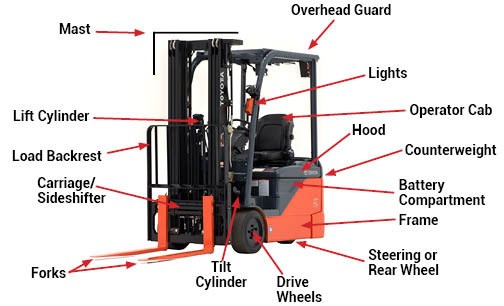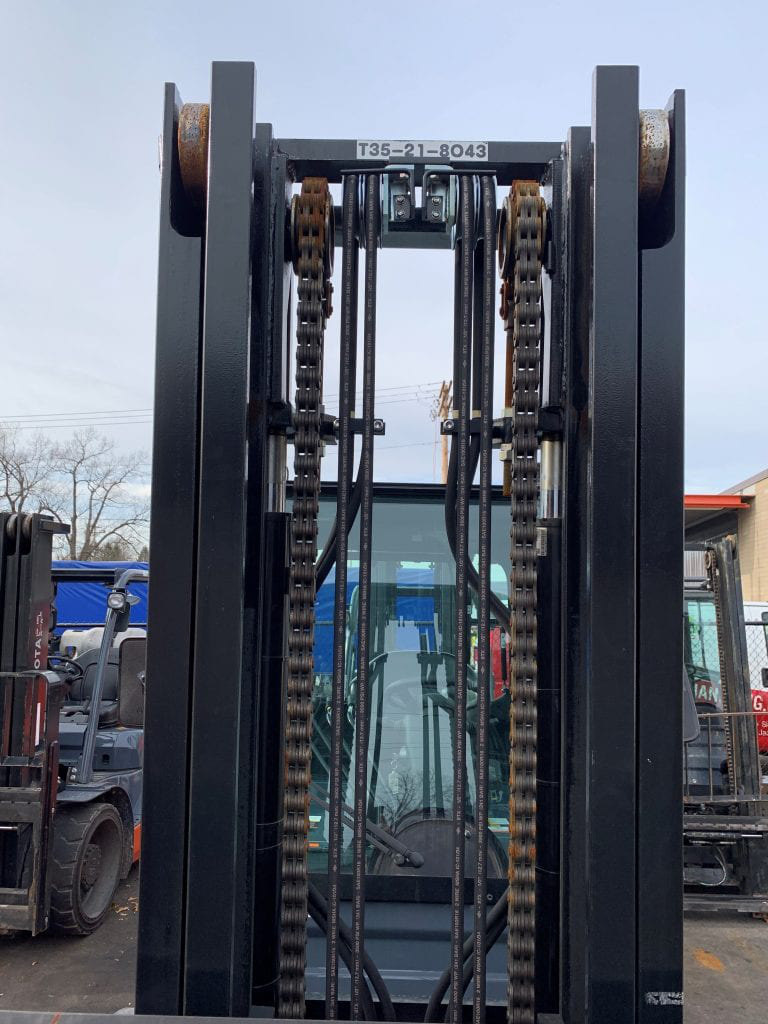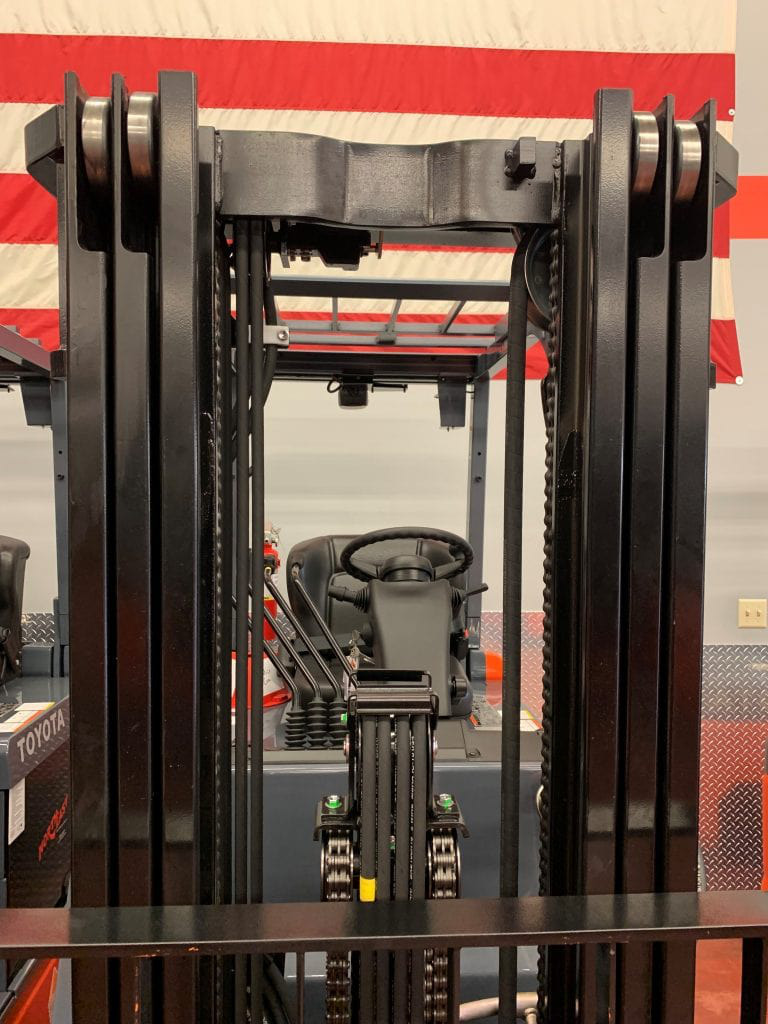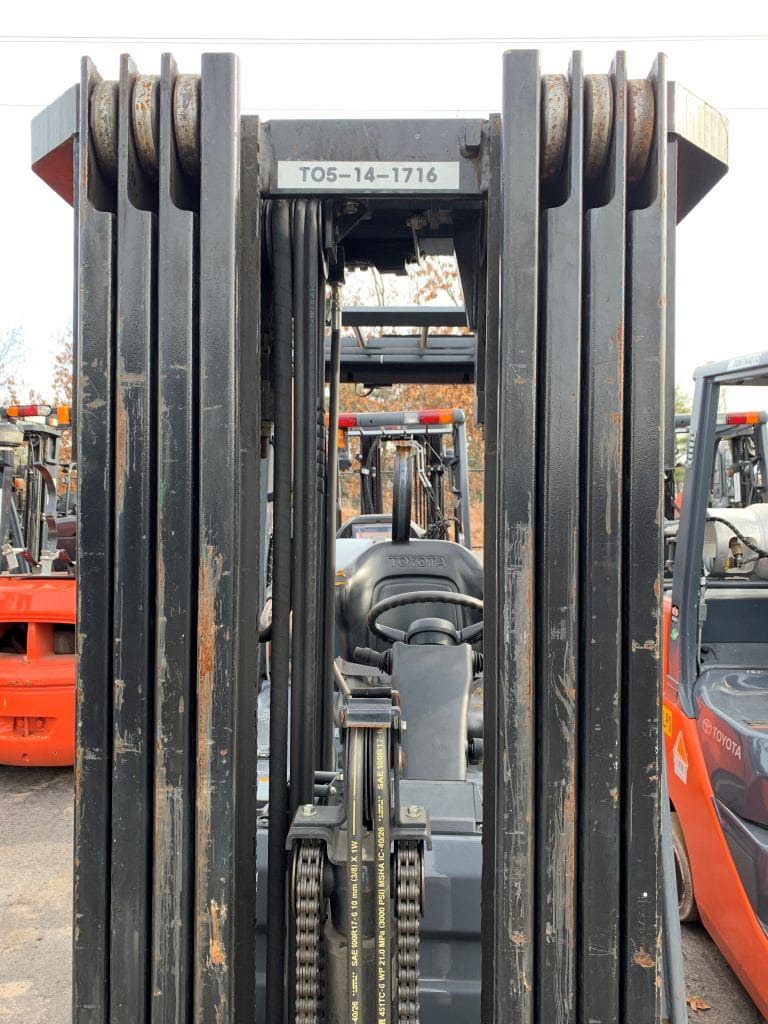Also referred to as an ‘Upright’, the mast is the vertical assembly on the front of the forklift that does the work of raising, lowering, and tilting the load. Most masts are ‘three stage’ meaning there are three channels on each side. The channels are similar in appearance to I-Beams.
Attached to the mast is the carriage. Attached to the carriage are the forks. The carriage is actuated by the hydraulic piston in the middle of the mast. By pulling the mast lever on the cowl it raises the load by actuating that piston, thus lifting the forks and your load. All masts lift by hydraulic displacement and lower by the force of gravity. From a simple direct lift to multiple channel staging, each mast type has features that enhance performance or extend the application range of the lift truck.

Free lift is the distance that the carriage will raise prior to the inner channel extending. This feature is imperative for double stacking in a trailer. Another feature that is an option but is now considered essential to most users is “side shift”. This feature allows horizontal movement of the forks to more precisely pick and place loads in less time.
Like the different types of forklifts, there are a number of mast types:
Single Stage Mast
Has one channel, limited ‘lift height’ (referred to on specification sheets as ‘MFH’-maximum fork height)
Also known as Simplex or V, standard has limited free lift (usually 4″-6”) and is used for lower lift heights.
Recommended Uses: Low lift heights, used primarily in self-propelled, walk-behind equipment
Two Stage Mast

Also known as Full Free Lift, FFL, Hilo, or FV, duplex is used when free lift is required but lift height is a minimal need. Common free lift is in the area of 50”. Lift truck capacity and maximum fork height dictate actual measurement.
A typical two-stage mast for a forklift with a capacity from 2,000 lbs. to 6,000 lbs. will have approximately 130″ of maximum lift and will be around 83-88″ Overall Height Lowered (OAHL). Two-stage masts are very common in high-capacity forklifts of 15,000 lbs. and up.
Recommended Uses: Low lift and full free lift applications.
Three Stage Mast

Also known as Triplex, Triple, TSU, and FSV, this is the most common type. It consists of three sections that extend the forks to their maximum lift height. In the middle of the mast is a hydraulic cylinder, referred to as the primary lift cylinder. This will raise the forks and carriage near the top of the mast prior to the sections staging up (known as ‘Free Lift’). Typical lift height for a triple stage mast for a forklift with base capacity from 2,000 lbs. to 6,000 lbs. will have 189″ of maximum lift and will be around 83″-88″ OAHL.
Recommended Uses: To load and unload higher than simplex or duplex or when full free lift is needed and duplex masts are not available.
Quad Mast

Also known as QFV, a four-stage mast has four sets of rails that raise the load. A quad will generally have a primary lift cylinder so it will have full free lift as well. It will have the same free lift as duplex or triplex mast but extends further. Can load and unload higher-tiered stacks than the duplex or triplex, but requires increased caution due to its high lifting heights. The typical lift height is 240” MFH, with 83″-88” OAHL.
Note: The lifting capacity of the forklift decreases as its load is raised.
Why These Differences Matter
One would think the only important aspect of a forklift mast is how high it can lift. However, the lowered height is sometimes just as crucial as the maximum lift height. If your application requires you to take a load through a door or your facility has any overhead restrictions, the down height is very important. Can you make it through all your doors? One step further, can you make it through your doors with your load raised 6 inches? Full free lift can make that difference when loading and unloading trucks on a dock, in a container, etc…
Keep in mind your capacity as well. Forklifts have a certain base capacity. As an example, consider a 5,000 lbs. cushion forklift with a triple mast and a side-shift attachment. While the forklift was built to handle a capacity of 5,000 lbs., but that was before the triple stage mast and side-shift. Those features (and others, including extended tilt) can “de-rate” your forklift so your maximum capacity when raised all the way to 188″, tilted all the way forward, and using your side-shift, could be as low as 2,500 lbs.
It is very important to spec out your forklift with these considerations in mind. If you have questions, contact us. We can help you figure out exactly what size forklift you need and what mast would be ideal for your application.
